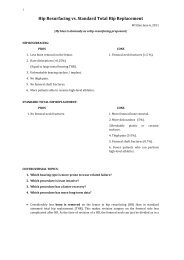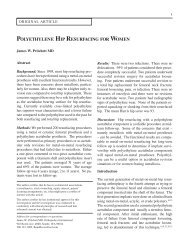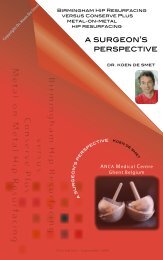Hip and Knee Arthroplasty - Surface Hippy Guide to Hip Resurfacing
Hip and Knee Arthroplasty - Surface Hippy Guide to Hip Resurfacing
Hip and Knee Arthroplasty - Surface Hippy Guide to Hip Resurfacing
Create successful ePaper yourself
Turn your PDF publications into a flip-book with our unique Google optimized e-Paper software.
(7.5%), pain (7.2%), lysis (6.9%) <strong>and</strong> patellofemoral<br />
pain (5.6%) (Table KR5).<br />
Analysis of First Revision of Known<br />
Primary <strong>Knee</strong> Replacement<br />
The essential difference between the known<br />
primary procedures subgroup of revisions<br />
compared <strong>to</strong> all revision procedures is that<br />
because the primary has been recorded by the<br />
Registry <strong>and</strong> the revision must have occurred<br />
subsequent <strong>to</strong> this, these revisions are either<br />
early or mid term revisions.<br />
Type of Revision <strong>Knee</strong> Replacement<br />
There are differences in the type of ‘revision in<br />
the known primary’ group when compared <strong>to</strong> the<br />
‘all revision’ group.<br />
The ‘revision of known primary’ group has a lower<br />
proportion of major revisions (63.1%) compared<br />
<strong>to</strong> the ‘all revision’ group (67.5%). There is also<br />
a reduction in the proportion of major revisions<br />
that are major <strong>to</strong>tal revisions (62.5% compared<br />
<strong>to</strong> 70.3%). Other differences include a higher<br />
proportion of femoral only major revisions<br />
(11.4% compared <strong>to</strong> 6.6%) <strong>and</strong> greater use of<br />
unicompartmental knee components (5.4%<br />
compared <strong>to</strong> 2.4%) (Table KR6). There is also a<br />
higher proportion of minor revisions (37.0%<br />
compared <strong>to</strong> 32.5%). The most common minor<br />
revisions are insert only (43.1%) <strong>and</strong> patellar<br />
resurfacing only (40.9%) (Table KR7).<br />
Diagnosis<br />
Diagnoses are similar between the ‘revision of<br />
known primary’ <strong>and</strong> ‘all revision’ groups with the<br />
exception of those diagnoses associated with<br />
wear. Diagnoses associated with wear occur<br />
more frequently in the ‘all revision’ group, with<br />
the exception of loosening which occurs in a<br />
similar proportion between the two groups. Pain<br />
<strong>and</strong> patello-femoral pain occur more frequently in<br />
the ‘revision of known primary’ group compared<br />
<strong>to</strong> the ‘all revision’ group (Table KR5).<br />
Outcome of Known Primary Revision<br />
<strong>Knee</strong> Replacement<br />
This analysis examines the risk of subsequent<br />
revision following the first revision of known<br />
primary unicompartmental <strong>and</strong> primary <strong>to</strong>tal knee<br />
replacement. Primary unispacer, partial<br />
resurfacing, patella/trochlear <strong>and</strong> bicompartmental<br />
procedures have been excluded from this<br />
analysis due <strong>to</strong> small numbers. First revisions<br />
revised for infection have been excluded for the<br />
same reasons as previously detailed in the<br />
outcomes of the first revision of ‘known primary’<br />
hip replacements.<br />
The outcomes of the first revision of known<br />
primary unicompartmental knee replacement<br />
(1,532 procedures) <strong>and</strong> known primary <strong>to</strong>tal knee<br />
replacement (3,122 procedures) are considered<br />
separately.<br />
Outcome of First Revision of Known<br />
Primary Unicompartmental <strong>Knee</strong><br />
Replacement<br />
The outcome of the first revision of primary<br />
unicompartmental knees is dependent on the<br />
type of first revision undertaken. There are four<br />
options for revising a unicompartmental knee<br />
replacement. The first three options are<br />
unicompartmental <strong>to</strong> unicompartmental revisions,<br />
minor revision (insert replacement), major partial<br />
unicompartmental revision (replacement of either<br />
the tibial or the femoral prosthesis) <strong>and</strong> major<br />
<strong>to</strong>tal unicompartmental revision (replacement of<br />
both femoral <strong>and</strong> tibial unicompartmental<br />
prostheses). The final option is <strong>to</strong> convert the<br />
unicompartmental knee <strong>to</strong> a <strong>to</strong>tal knee<br />
replacement.<br />
Revision <strong>to</strong> a <strong>to</strong>tal knee has a significantly lower<br />
rate of re-revision compared <strong>to</strong> a<br />
unicompartmental <strong>to</strong> unicompartmental option.<br />
The outcome of the three different<br />
unicompartmental <strong>to</strong> unicompartmental options<br />
appear similar, however it is difficult <strong>to</strong> be certain<br />
about the major <strong>to</strong>tal unicompartmental revision<br />
group as only a few of these procedures have<br />
been performed (Table KR8).<br />
Unicompartmental <strong>to</strong> unicompartmental revisions<br />
when combined in<strong>to</strong> one group have a revision<br />
rate of 9.3 revisions per 100 observed<br />
compartment years compared <strong>to</strong> 3.0 for<br />
unicompartmental <strong>to</strong> <strong>to</strong>tal knee. The rate of<br />
revision of a unicompartmental <strong>to</strong><br />
unicompartmental revision is almost three times<br />
greater than a unicompartmental <strong>to</strong> <strong>to</strong>tal knee<br />
(hazard ratio (adjusted for age <strong>and</strong> sex) (Adj<br />
HR)=2.97; 95% CI (2.14, 4.14) p






